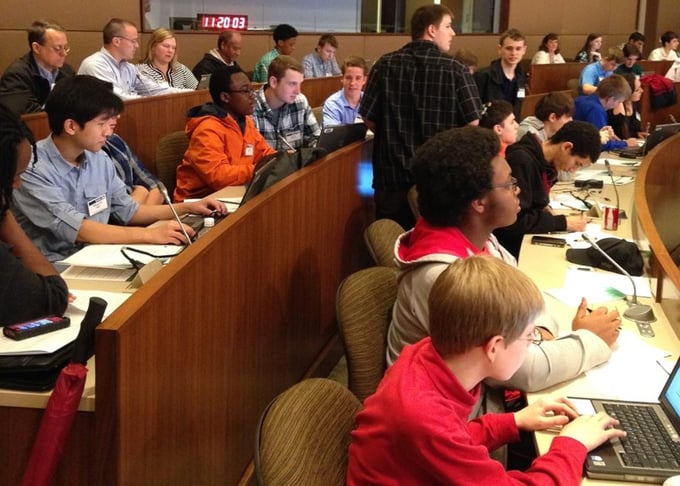Tim Velegol is engineering program coordinator and CTE department chair at Riverside High School in Durham, North Carolina.
When we were invited to become a part of the pilot PLTW Computer Science program that PLTW rolled out three years ago, it was like a dream come true. Despite the dire predictions about the country's shortage of qualified CS professionals, our school and its engineering program didn't have a single computer science class in it. In those three short years, the enrollment for Computer Science Principles (CSP) has doubled from the original 20 to 40, and the only reason we can't offer a third section of the course this year is because we don't have enough teachers to support it.
It sounds a little intimidating to most that what is "not a programming class" includes Scratch, App Inventor, Python, HTML, CSS, mySQL, PHP, Javascript, and GitHub. Not being a programmer myself, I was also a bit skeptical and, admittedly at first, a little overwhelmed. Not knowing anything about the fundamentals of how the Internet worked or basically any of the course content, I wondered how it would play with our student body.
It didn't take long to discover that much in the same way that it might intimidate teachers, the concept of "getting comfortable with being uncomfortable" in approaching the content also discomforts teenagers. Many students are accustomed to being able to "master" course content in almost every class they take; diving into any one of the programs touched on during the class, let alone all of them, can be daunting.
Continuous reassurance from the instructor, however, eventually gets students into the swing of computational thinking and before long, they start being OK with the fact that there isn't necessarily "one right answer," although the multiple possible answers aren't as subjectively assessed as they might be in an English or history class.
This culminates in what I think has been a tough, but fair, End-of-Course (EoC) assessment. And just as success breeds success, students who enter the exam thinking they don't know anything discover that, in fact, their literacy skills have been considerably honed by learning to think computationally, and they know a lot more than they give themselves credit for. This, in turn, leads to word-of-mouth referrals by peers, and I won't be surprised if, in five years, CSP becomes ones of the most popular classes in the school. It really is fun, and the additional resources that are available are infinite.
The stereotype of the "kind of student" who can succeed at CS remains ever-present, but I think we are winning that battle, too, with increasing numbers of girls and minorities engaged in the class.
The photo above shows a group of our kids on a field trip to SAS, which is consistently rated as one of the top five companies to work for in America. Every year, it is an eye-opening experience for them to witness how directly the classroom learning maps to a real-life job in ideal surroundings, and SAS puts on a tremendous program to sell the value-add of computational thinking in their industry-leading data analytics.
I think an email from one CSP alumnus after his first year of college sums it up beautifully: " ... let the (students in the) Engineering Wing know that if they want to pass their first real engineering class, then they really should take Computer Science."
PLTW’s blog is intended to serve as a forum for ideas and perspectives from across our network. The opinions expressed are those of this guest author.

